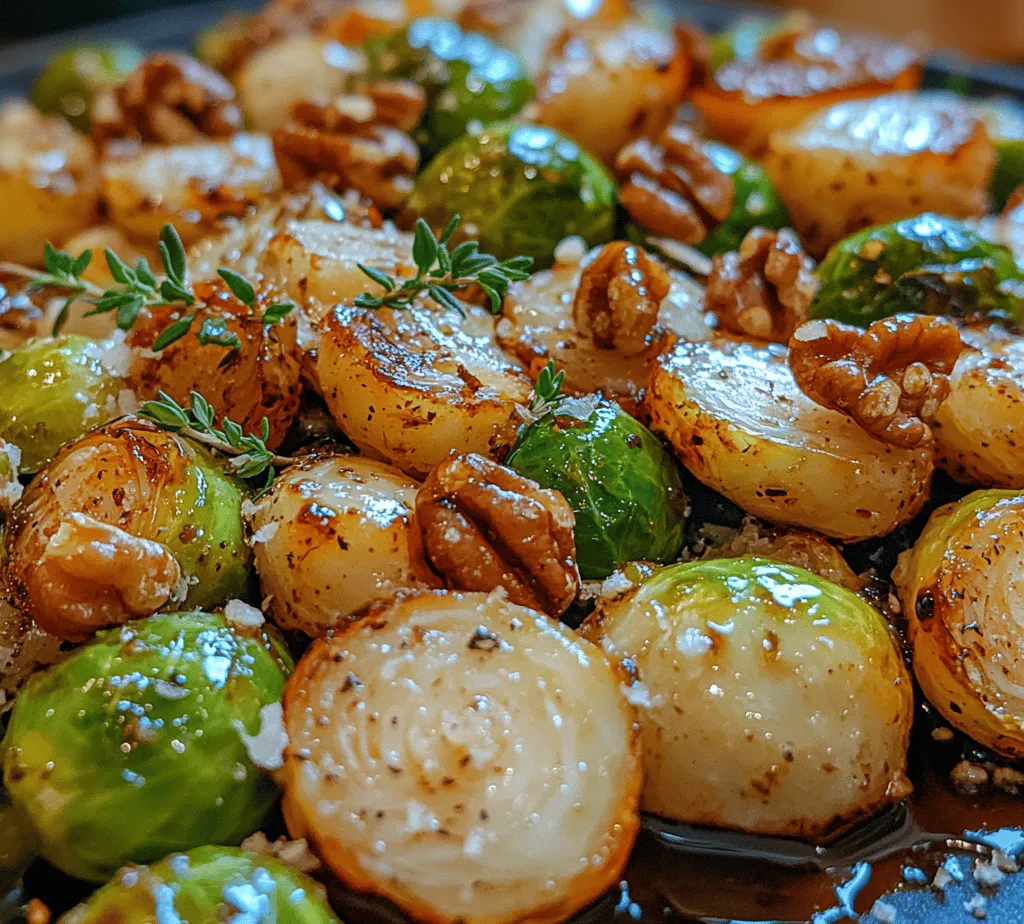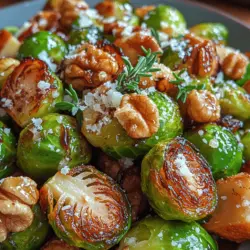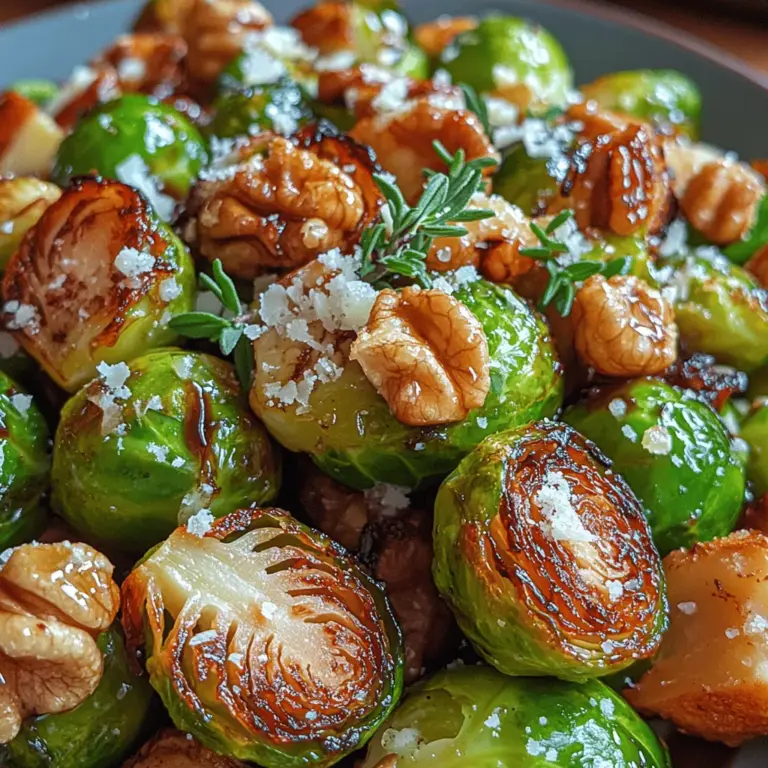Introduction
Brussels sprouts, once relegated to the sidelines of holiday feasts, have surged in popularity, emerging as a trendy vegetable that garners praise from health enthusiasts and culinary aficionados alike. These small, green gems are not only visually appealing but are also brimming with nutritional benefits, making them a fantastic choice for anyone looking to incorporate more vegetables into their diet. In this article, we will explore a delectable recipe for Balsamic Roasted Brussels Sprouts, a dish that epitomizes simplicity while delivering an explosion of flavor.
What makes this recipe stand out is its ease of preparation combined with the robust taste profile it offers. Balsamic Roasted Brussels Sprouts are a culinary delight that is both satisfying and versatile, making them an ideal side dish for a variety of occasions—from casual weeknight dinners to elegant holiday feasts. Whether you’re a seasoned cook or just beginning your culinary journey, this recipe will guide you through the steps to create a flavorful dish that will have everyone asking for seconds.
Understanding Brussels Sprouts
Nutritional Benefits of Brussels Sprouts
Brussels sprouts are not only delicious but also packed with a wealth of nutrients. They are an excellent source of vitamins C and K, both of which play vital roles in maintaining a healthy immune system and promoting bone health. Additionally, Brussels sprouts are rich in dietary fiber, which aids digestion and helps maintain a healthy gut. They also contain antioxidants, which can protect the body from oxidative stress and reduce the risk of chronic diseases. With fewer calories and a high nutrient density, including Brussels sprouts in your meals is a smart choice for anyone looking to eat healthily.
History and Origin of Brussels Sprouts
The history of Brussels sprouts can be traced back to ancient times, with origins believed to be in the Mediterranean region. However, they gained prominence in Brussels, Belgium, during the 16th century, which is where they derive their name. Over the centuries, these vegetables have been cultivated and refined, leading to the varieties we enjoy today. Initially introduced to North America in the 18th century, Brussels sprouts have since become a staple in various cuisines, especially in the United States and Europe, where they are often featured in seasonal dishes.
Culinary Importance of Brussels Sprouts in Different Cuisines
Brussels sprouts have found a place in many culinary traditions around the world. In European cuisine, they are often boiled or steamed and served as a side dish, particularly during festive occasions. In contrast, modern culinary trends have embraced roasting, sautéing, and even grilling Brussels sprouts to enhance their natural sweetness and develop a crispy texture. The versatility of Brussels sprouts allows them to pair beautifully with a range of flavors, from savory meats to bright citrus dressings, making them a favorite ingredient among chefs and home cooks alike.
Why Choose Balsamic Roasted Brussels Sprouts?
Flavor Profile of Balsamic Vinegar
Balsamic vinegar is a key ingredient in this recipe, and its unique flavor profile is what elevates the Brussels sprouts to a new level. With its rich, sweet, and tangy characteristics, balsamic vinegar complements the natural earthiness of Brussels sprouts beautifully. The acidity of the vinegar helps to cut through the richness of the dish, creating a harmonious balance that tantalizes the taste buds. When roasted, the balsamic vinegar caramelizes on the Brussels sprouts, imparting a deep, complex flavor that is simply irresistible.
Balancing Sweetness and Savory Elements
In addition to balsamic vinegar, this recipe may include honey or maple syrup, which adds a layer of sweetness that beautifully balances the savory elements of the dish. The sweetness from these ingredients enhances the natural flavors of the Brussels sprouts, while also contributing to the overall caramelization during roasting. This combination of sweet and savory is what makes Balsamic Roasted Brussels Sprouts such a crowd-pleaser, appealing to a wide range of palates.
Health Benefits of Using Olive Oil and Fresh Ingredients
The use of extra-virgin olive oil in this recipe not only adds a rich flavor but also provides numerous health benefits. Olive oil is known for its heart-healthy monounsaturated fats and its anti-inflammatory properties. By using high-quality olive oil, you can enhance the nutritional value of the dish while also achieving the perfect texture during roasting. Moreover, incorporating fresh, high-quality ingredients—such as garlic and herbs—ensures that every bite is bursting with flavor and nutrients, making this recipe a wholesome addition to your meal rotation.
Ingredient Breakdown
Brussels Sprouts: Choosing the Best Quality and Size for Roasting
When selecting Brussels sprouts for this recipe, opt for firm, vibrant green sprouts that are free from blemishes or yellowing leaves. The size of the Brussels sprouts can vary, but medium-sized ones are generally preferred for roasting, as they cook evenly and develop a delightful crispiness. If you encounter larger sprouts, consider cutting them in half to ensure uniform cooking. Fresh Brussels sprouts are typically available during the cooler months, making them a seasonal delight that should be enjoyed when they are at their peak.
Extra-Virgin Olive Oil: Importance of Quality and Health Benefits
Extra-virgin olive oil is a cornerstone of Mediterranean cuisine and is known for its superior flavor and health benefits. When choosing olive oil for roasting Brussels sprouts, look for high-quality extra-virgin options that are cold-pressed and minimally processed. This ensures that you are getting the most flavor and nutritional benefits, as quality olive oil contains antioxidants and healthy fats that enhance overall well-being. The rich, fruity notes of extra-virgin olive oil will complement the Brussels sprouts beautifully, adding depth to the dish while also promoting heart health.
Balsamic Vinegar: Different Types Available and Their Flavor Nuances
Balsamic vinegar comes in various types, each with its unique characteristics and flavor profiles. Traditional balsamic vinegar, which is aged for a longer period, tends to have a complex, sweet flavor with a thick consistency. On the other hand, commercial balsamic vinegar is often less expensive and has a more pronounced acidity, making it a great option for everyday cooking. When selecting balsamic vinegar for this recipe, aim for a high-quality product that balances sweetness and acidity, as this will enhance the overall flavor of the Brussels sprouts.
Honey vs. Maple Syrup: Analyzing Flavor Differences and Potential Substitutions
In this recipe, you have the option to use either honey or maple syrup to add sweetness to the dish. Honey offers a floral sweetness that pairs beautifully with the tanginess of balsamic vinegar, while maple syrup provides a warm, caramel-like flavor that can add depth to the dish. Both options are delicious, so feel free to choose based on your personal preference or dietary restrictions. If you are looking for a vegan alternative, maple syrup is an excellent choice. Additionally, if you’re experimenting with flavors, consider using agave nectar or coconut sugar as substitutes for a unique twist.
Garlic: Its Role in Enhancing the Dish’s Aroma and Taste
Garlic is a staple ingredient in many cuisines, and its inclusion in Balsamic Roasted Brussels Sprouts is no exception. Adding fresh garlic not only enhances the aroma of the dish but also infuses the Brussels sprouts with a savory depth of flavor. When roasted, garlic becomes sweet and mellow, complementing the natural bitterness of the sprouts. For an extra kick, consider using roasted garlic, which provides a rich, caramelized flavor that elevates the dish even further.
Herbs and Spices: The Impact of Thyme and the Importance of Seasoning
Herbs and spices play a crucial role in flavoring Balsamic Roasted Brussels Sprouts, and thyme is an excellent choice for this recipe. Its earthy, aromatic notes harmonize beautifully with the other ingredients, enhancing the overall flavor profile. Fresh thyme adds a more vibrant taste, while dried thyme can still impart a lovely essence when fresh is unavailable. Additionally, don’t forget to season your Brussels sprouts generously with salt and pepper before roasting, as this will enhance the natural flavors and ensure a well-rounded dish.
Parmesan Cheese: A Discussion on Its Optional Use and Variations
While Parmesan cheese is an optional ingredient for this recipe, it can add a delightful umami flavor that complements the Brussels sprouts beautifully. If you choose to include Parmesan, freshly grated cheese is recommended for the best taste and texture. For those looking for a dairy-free alternative, consider using nutritional yeast, which offers a cheesy flavor without the dairy. Additionally, feel free to experiment with other cheese options, such as feta or goat cheese, for a unique twist that adds creaminess and richness to the dish.
In the next section, we will delve into the step-by-step instructions for preparing Balsamic Roasted Brussels Sprouts, ensuring you achieve perfect results every time. Whether you’re serving them as a side dish or a main attraction, these flavorful sprouts are sure to impress and satisfy.

Nuts: The Benefits of Adding Toasted Walnuts or Pecans for Texture
To elevate your Balsamic Roasted Brussels Sprouts, consider incorporating toasted walnuts or pecans. These nuts not only add delightful crunch but also contribute essential nutrients and healthy fats. Nuts are known for their heart-healthy properties, providing omega-3 fatty acids, proteins, and fiber. The rich, buttery flavor of toasted walnuts or the sweet, earthy notes of pecans complement the tangy balsamic glaze beautifully, creating a well-rounded dish that is both satisfying and nutritious.
Step-by-Step Guide to Preparing Balsamic Roasted Brussels Sprouts
Preheating the Oven: Importance of Temperature in Achieving the Perfect Roast
Start by preheating your oven to 400°F (200°C). The importance of this step cannot be overstated; a properly preheated oven ensures that your Brussels sprouts roast evenly and develop that coveted caramelization. This temperature allows the natural sugars in the sprouts to enhance their flavor while providing a crispy exterior. If you skip this step, you risk undercooked or soggy sprouts that won’t deliver the delightful texture and taste you’re aiming for.
Preparing the Brussels Sprouts: Tips for Trimming and Halving for Even Cooking
Once your oven is preheated, it’s time to prepare the Brussels sprouts. Begin by washing them thoroughly under cold water to remove any dirt or debris. After rinsing, trim the stem end of each sprout with a sharp knife, removing any discolored leaves. For even cooking, halve each sprout from top to bottom. This will help them cook more uniformly and allows the balsamic glaze to penetrate better, enhancing their flavor. If you have particularly large sprouts, consider quartering them for the best results.
Mixing the Ingredients: Best Practices for Tossing the Sprouts with the Marinade
In a large mixing bowl, combine your halved Brussels sprouts with olive oil, balsamic vinegar, salt, and pepper. The key to a flavorful dish is to ensure that every sprout is well coated. Use your hands or a large spoon to toss the ingredients together gently but thoroughly. The oil helps to promote caramelization, while the balsamic vinegar adds acidity and depth. If you’re including nuts, add them to the mixture now so they absorb the flavors before roasting.
Arranging on the Baking Sheet: The Significance of Spacing for Even Roasting
Once your Brussels sprouts are coated, it’s time to arrange them on a baking sheet. Spread the sprouts out in a single layer, ensuring they have space between them. Crowding the pan can lead to steaming rather than roasting, which prevents the sprouts from achieving that perfect crispy texture. If you’re using a larger batch, consider using two baking sheets to maintain adequate space. For an added touch, line your baking sheet with parchment paper for easy cleanup and to prevent sticking.
Roasting Process: Insights into the Science of Roasting Vegetables
Place the baking sheet in the preheated oven and roast the Brussels sprouts for about 20 to 25 minutes. Halfway through the cooking time, take the pan out and give the sprouts a good toss to ensure even browning. The science behind roasting is fascinating; high heat causes the natural sugars in the Brussels sprouts to caramelize, resulting in a deep, rich flavor. Keep an eye on them towards the end of the cooking time; you want them to be tender yet crisp, with a beautiful golden-brown color.
Adding Cheese: How to Incorporate Cheese Effectively for Maximum Flavor
If you want to take your Balsamic Roasted Brussels Sprouts to the next level, consider adding cheese. Feta or goat cheese are excellent choices, as their tanginess complements the balsamic glaze. To incorporate cheese effectively, sprinkle it over the Brussels sprouts during the last 5 minutes of roasting. This allows the cheese to soften and meld into the dish without losing its character. If you prefer a more decadent option, try using freshly grated Parmesan and broil the sprouts for a minute or two to create a bubbly, golden crust.
Garnishing: Suggestions for Presentation and Enhancing Visual Appeal
Presentation matters, especially when it comes to enticing your guests. Once the Brussels sprouts are perfectly roasted, transfer them to a serving platter. You can garnish the dish with a sprinkle of freshly chopped herbs, such as parsley or thyme, for a pop of color and fresh flavor. A drizzle of balsamic reduction over the top can also enhance visual appeal while adding an extra layer of richness. For an even more visually striking presentation, consider serving your Brussels sprouts in a rustic cast-iron skillet or a vibrant ceramic dish.
Flavor Enhancements and Variations
Customizing the Recipe with Different Herbs and Spices
One of the beautiful aspects of Balsamic Roasted Brussels Sprouts is their versatility. You can customize the flavor profile by introducing various herbs and spices. For a more robust flavor, try adding minced garlic or shallots to the mix before roasting. Fresh herbs like rosemary or thyme can add an aromatic touch, while a sprinkle of red pepper flakes can introduce a hint of heat. Experimenting with spices will allow you to make this dish uniquely yours.
Exploring Alternative Sweeteners for Various Dietary Preferences
If you’re looking to modify the recipe to accommodate different dietary needs, consider using alternative sweeteners. While traditional balsamic vinegar has its sweetness, you can enhance it further with maple syrup or honey for a more pronounced flavor. For a sugar-free option, look for sugar-free maple syrup or a dash of agave nectar, which can provide a similar sweetness without the added calories.
Additional Toppings or Mix-ins to Elevate the Dish Further
For those who love to experiment in the kitchen, consider adding additional toppings or mix-ins to elevate your Balsamic Roasted Brussels Sprouts. Crispy bacon or pancetta can add a savory element, while dried cranberries or pomegranate seeds can introduce a sweet touch. Sun-dried tomatoes can also offer a tangy burst of flavor that complements the balsamic glaze beautifully. These additions not only enhance taste but also add layers of texture to the dish.
Ideas for Pairing Balsamic Roasted Brussels Sprouts with Main Courses
Balsamic Roasted Brussels Sprouts make a fantastic side dish that pairs well with various main courses. They complement roasted meats like chicken or pork tenderloin beautifully, providing a rich contrast to the savory flavors. For a vegetarian option, serve them alongside grain bowls or stuffed peppers. The tangy balsamic glaze also pairs nicely with grilled fish, adding a touch of acidity that balances the dish perfectly.
Serving Suggestions
Presenting the Dish: Importance of Plating for Visual Appeal
When it comes to serving your Balsamic Roasted Brussels Sprouts, presentation is key. Use a large, shallow bowl or platter to showcase the vibrant colors of the roasted sprouts. You can create height by stacking them in the center of the plate and letting them cascade down the sides. This visual appeal can make a simple side dish feel like a gourmet offering. Consider adding a few whole sprouts or nuts on top for a finishing touch that invites guests to dig in.
Optimal Serving Temperature and Ways to Keep the Sprouts Warm
Ideally, Brussels sprouts are best served warm, right after roasting when they are still crispy. If you need to prepare them in advance, you can keep them warm in a low oven (around 200°F or 93°C) until ready to serve. Covering them loosely with aluminum foil will help retain heat while preventing them from becoming soggy. If you have leftovers, store them in an airtight container in the refrigerator and reheat in a hot skillet for the best texture.
Pairing Options: Ideal Main Dishes and Beverages to Accompany the Sprouts
To create a well-rounded meal, consider the ideal main dishes and beverages that complement your Balsamic Roasted Brussels Sprouts. A roasted chicken seasoned with herbs can provide a deliciously savory contrast, while a rich mushroom risotto can create a comforting vegetarian meal. As for beverages, a light-bodied red wine like Pinot Noir pairs beautifully with the earthy flavors of the sprouts. If you prefer something non-alcoholic, a sparkling apple cider or herbal iced tea can refresh the palate.
Conclusion
Balsamic Roasted Brussels Sprouts are truly a flavor bomb that can transform any meal into a gourmet experience. With their perfect combination of sweetness, tang, and crunch, these sprouts not only satisfy the taste buds but also offer numerous health benefits. Packed with vitamins, fiber, and healthy fats, they make for a nutritious addition to your dining table.
As you explore this delightful recipe, remember that its versatility allows for endless customization to suit your palate. From adding nuts for texture to experimenting with various flavors, incorporating Balsamic Roasted Brussels Sprouts into your cooking repertoire will surely impress family and friends alike. So why not give this delicious recipe a try and enjoy the burst of flavor it brings to your meals?


